Septic Services
Septic Compliance Inspections
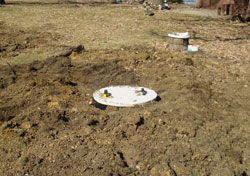 A compliance inspection is an evaluation, investigation, inspection or other such process conducted for the purpose of issuing a Certificate of Compliance or Notice of Non-compliance.
A compliance inspection is an evaluation, investigation, inspection or other such process conducted for the purpose of issuing a Certificate of Compliance or Notice of Non-compliance.
After cleaning your septic tank, Beemer Companies will inspect your onsite wastewater management system. This includes evaluating the condition of the tank - particularly looking for cracks and signs of infiltration, and confirming that baffles are all in place. If this is a compliance inspection needed before selling your home or to obtain a building permit, we will have one of our licensed designers and inspectors come on site.
Effluent Pump Services
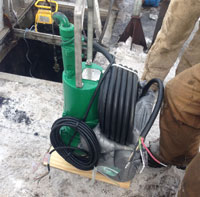 Beemer Companies provides installation and maintenance for effluent pumps in Southern Minnesota and Northern Iowa. An effluent style of sump pump is designed for only the liquid portion of sewage. We offer 24 hour emergency service and can respond quickly to any pump station or grease trap emergencies. Whether commercial or residential, we offer a variety of services including repairs, pumping, and preventative maintenance for stations of every size.
Beemer Companies provides installation and maintenance for effluent pumps in Southern Minnesota and Northern Iowa. An effluent style of sump pump is designed for only the liquid portion of sewage. We offer 24 hour emergency service and can respond quickly to any pump station or grease trap emergencies. Whether commercial or residential, we offer a variety of services including repairs, pumping, and preventative maintenance for stations of every size.
Septic Designing Services
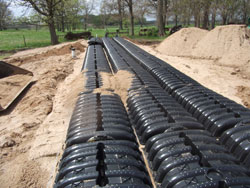 A septic design is a crucial component of your septic system. The design lays out the foundation of a suitable system for your needs and soil conditions. Any compromise would likely result in premature failure of an expensive installation. Beemer Companies takes site and user specific conditions and incorporates them into your septic design. Having Beemer Companies design a site-specific system for you would likely result in one that could last 20 to 30 years with proper scheduled maintenance.
A septic design is a crucial component of your septic system. The design lays out the foundation of a suitable system for your needs and soil conditions. Any compromise would likely result in premature failure of an expensive installation. Beemer Companies takes site and user specific conditions and incorporates them into your septic design. Having Beemer Companies design a site-specific system for you would likely result in one that could last 20 to 30 years with proper scheduled maintenance.
Septic Absorption Field Services
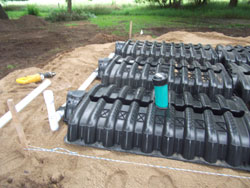 The most common form of on-site sewage disposal is a septic tank/soil absorption system. A conventional septic system consists of a septic tank, distribution box, and an absorption field installed below the soil surface.
The most common form of on-site sewage disposal is a septic tank/soil absorption system. A conventional septic system consists of a septic tank, distribution box, and an absorption field installed below the soil surface.
Wastewater is distributed throughout the absorption system by pipe, then flows through to the trenches and soaks down into the ground. The soil both treats and disposes of the wastewater. Blockages in the pipe between the home and the tank can usually be cleared with plumbers' tools. If your plumbing backs up suddenly under normal use in dry weather this is probably the problem. However, some pipe blockages caused by tree roots entering the pipe or detergent buildup, can develop over a period of time. More serious difficulties occur when the absorption system becomes clogged or saturated. The most common cause of absorption system clogging is carryover of solids from the septic tank. When sludge and scum are not periodically removed from the tank, they accumulate until they are washed out into the absorption field. Eventually pores in the earth walls of the soil become clogged. A leach field which is only partially clogged may work well during dry weather, but when winter rains soak the ground, or when household use is high, the system becomes overloaded and failure becomes apparent. You may be able to clear blockages in the distribution pipe, but once the soil becomes clogged it will no longer accept the wastewater and you will need a new absorption system. It's a lot cheaper to keep your system working well through proper maintenance.
Septic Tank Pumping Services
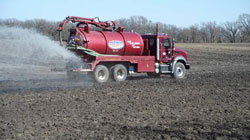 Beemer Companies recommends that under normal conditions, you should pump your septic tank every 1-3 years based upon the number of people living in your home. Generally, this pumping will take around 30-45 minutes. If you know the location of your septic system and have your septic lids exposed, this could save you some money on the back end because our professional pumper won't have to take the time to locate and expose it.
Beemer Companies recommends that under normal conditions, you should pump your septic tank every 1-3 years based upon the number of people living in your home. Generally, this pumping will take around 30-45 minutes. If you know the location of your septic system and have your septic lids exposed, this could save you some money on the back end because our professional pumper won't have to take the time to locate and expose it.
Septic Systems
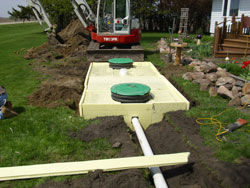 Most people don't know that there are nearly as many types and sizes of septic systems as there are cars on a new car lot. In Minnesota, the systems are divided up into three basic categories; Standard Gravity, Pressure Distribution, and Advanced Treatment.
Most people don't know that there are nearly as many types and sizes of septic systems as there are cars on a new car lot. In Minnesota, the systems are divided up into three basic categories; Standard Gravity, Pressure Distribution, and Advanced Treatment.
A standard gravity septic system works by letting gravity drain the effluent from the septic tank into a series of underground trenches. This means the soil treatment system area must be below the elevation of the septic tank. If this is not the case, then a pump is necessary and it is called a pump to standard gravity system.
Pressure distribution systems are usually required when there is less than optimal soil depth available for complete treatment of the effluent by a gravity system. A minimum of two feet of properly drained soil is required under the trenches. The tank and soil treatment system area size are normally the same as a standard gravity system, but the method by which the effluent is distributed to the soil is different.
Advanced treatment systems come in MANY makes and varieties. These systems are required when shallow soils exist on the site (12-30 inches). The basic function of these systems is to clean the wastewater prior to the final disposal into the ground. Most of the time, these treatment systems are followed by pressure distribution soil treatment system areas.
Video Inspection
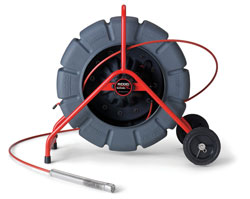 Pipe inspection video cameras have become one of the most valuable tools in the plumbing business. Specially made fiber optic cameras allow for a visual inspection of underground pipes and other piping to determine the condition of the inside of the pipe. A flexible rod with a high-resolution color video camera on its tip is inserted into the pipe for inspection. Video images are transmitted to the camera operator and are digitally saved onto the system's hard drive for a permanent record. Radio transmitters on the camera allow a line locator to record the depth and physical location from the surface so that defects and obstructions can be located and repaired with less disturbance.
Pipe inspection video cameras have become one of the most valuable tools in the plumbing business. Specially made fiber optic cameras allow for a visual inspection of underground pipes and other piping to determine the condition of the inside of the pipe. A flexible rod with a high-resolution color video camera on its tip is inserted into the pipe for inspection. Video images are transmitted to the camera operator and are digitally saved onto the system's hard drive for a permanent record. Radio transmitters on the camera allow a line locator to record the depth and physical location from the surface so that defects and obstructions can be located and repaired with less disturbance.



contacts
Address: 1988 135th Street, Fairmont MN 56031
Phone: 800-5-BEEMER
Fax: 507-235-6722
Email: Contact Form

